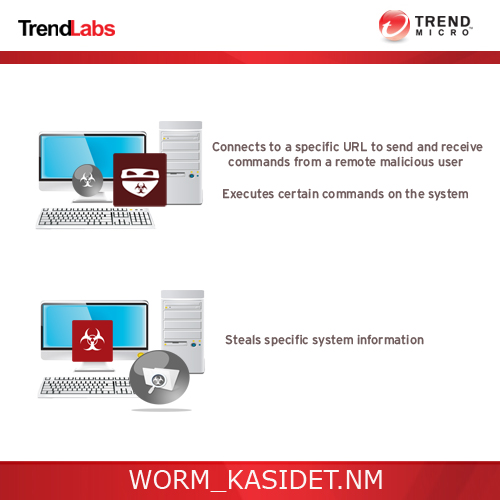WORM_KASIDET.NM
Worm:Win32/Kasidet.B (Microsoft); Trojan.Kasidet (Symantec)
Windows


Threat Type: Worm
Destructiveness: No
Encrypted: Yes
In the wild: Yes
OVERVIEW
This is one of the samples related to the Neutrino bot or Kasidet. Its code was leaked in the underground forum last July 2015. This malware, which has PoS-scraping routines, is also the payload for the Sundown exploit kit.
To get a one-glance comprehensive view of the behavior of this Worm, refer to the Threat Diagram shown below.

This worm arrives on a system as a file dropped by other malware or as a file downloaded unknowingly by users when visiting malicious sites.
It executes commands from a remote malicious user, effectively compromising the affected system.
TECHNICAL DETAILS
Arrival Details
This worm arrives on a system as a file dropped by other malware or as a file downloaded unknowingly by users when visiting malicious sites.
Installation
This worm drops the following files:
- %User Temp%\nsu2C5.tmp
- %User Temp%\bin.exe
- %User Temp%\nsz2C6.tmp\Samian.dll
- %Application Data%\tag(2)
- %Application Data%\Read Me Info.txt
- %Application Data%\jackajeoaer.jpg
- %Application Data%\index(11).php
- %Application Data%\photo(5).jpg;
(Note: %User Temp% is the user's temporary folder, where it usually is C:\Documents and Settings\{user name}\Local Settings\Temp on Windows 2000, Windows Server 2003, and Windows XP (32- and 64-bit); C:\Users\{user name}\AppData\Local\Temp on Windows Vista (32- and 64-bit), Windows 7 (32- and 64-bit), Windows 8 (32- and 64-bit), Windows 8.1 (32- and 64-bit), Windows Server 2008, and Windows Server 2012.. %Application Data% is the Application Data folder, where it usually is C:\Documents and Settings\{user name}\Application Data on Windows 2000, Windows Server 2003, and Windows XP (32- and 64-bit); C:\Users\{user name}\AppData\Roaming on Windows Vista (32- and 64-bit), Windows 7 (32- and 64-bit), Windows 8 (32- and 64-bit), Windows 8.1 (32- and 64-bit), Windows Server 2008, and Windows Server 2012.)
Propagation
This worm drops the following copy(ies) of itself in all removable drives:
- {Drive Letter}:\WinSystemKB001.exe -copy of itself
- {Drive Letter}:\autorun.inf - autorun technique
Backdoor Routine
This worm executes the following commands from a remote malicious user:
- Loads arbitrary file
- Find files
- Spread through removable drives
- Infect .RAR files
- Perform Flood attacks (HTTP, SLOW, DWFLOOD, TCP, UDP, SMART, HTTPS)
- Start keylogging routine
- Update itself
- Uninstall itself
- Perform remote shell
- Modify HOSTS file
- Search running process for credit card data
It connects to the following URL(s) to send and receive commands from a remote malicious user:
- http://www.{BLOCKED}eagaaa.ws/login/tasks.php
- http://www.{BLOCKED}tycheckpointsdomain.com/users/tasks.php
- http://www.{BLOCKED}tydomains1.com/security/tasks.php
- http://www.{BLOCKED}esecurity.ws/login/tasks.php
Information Theft
This worm gathers the following data:
- User ID
- OS Version
- AV software installed
- NAT installed
- Product key
NOTES:
The randomly named file may be any of the following:
- KIS_keygen.exe
- Keygen.exe
- RealPhoto.exe
- Readme.exe
- Tutorial.exe
- photo_private.exe
- WinUpdate.exe
- CS16.exe
- VKHackePri8.exe
- DotaMagic.exe
- Update.exe
This backdoor checks for the following:
- Debugger and Virtualization registries and applications:
- VMWare
- Wine
- Sandboxie
- Qemu
- VirtualBox
- Computer name contains the following strings:
- MALTEST
- TEQUILABOOMBOOM
- SANDBOX
- VIRUS
- MALWARE
- Path of the file contains the following strings:
- \SAMPLE
- \VIRUS
- SANDBOX
If any of the conditions is met, it terminates itself and displays an error message.
SOLUTION
Step 1
Before doing any scans, Windows XP, Windows Vista, and Windows 7 users must disable System Restore to allow full scanning of their computers.
Step 2
Note that not all files, folders, and registry keys and entries are installed on your computer during this malware's/spyware's/grayware's execution. This may be due to incomplete installation or other operating system conditions. If you do not find the same files/folders/registry information, please proceed to the next step.
Step 3
Restart in Safe Mode
Step 4
Search and delete this file
- %User Temp%\nsu2C5.tmp
- %User Temp%\bin.exe
- %User Temp%\nsz2C6.tmp\Samian.dll
- %Application Data%\tag(2)
- %Application Data%\Read Me Info.txt
- %Application Data%\jackajeoaer.jpg
- %Application Data%\index(11).php
- %Application Data%\photo(5).jpg;
Step 5
Restart in normal mode and scan your computer with your Trend Micro product for files detected as WORM_KASIDET.NM. If the detected files have already been cleaned, deleted, or quarantined by your Trend Micro product, no further step is required. You may opt to simply delete the quarantined files. Please check this Knowledge Base page for more information.
Step 6
Scan your computer with your Trend Micro product to delete files detected as WORM_KASIDET.NM. If the detected files have already been cleaned, deleted, or quarantined by your Trend Micro product, no further step is required. You may opt to simply delete the quarantined files. Please check this Knowledge Base page for more information.
Did this description help? Tell us how we did.


